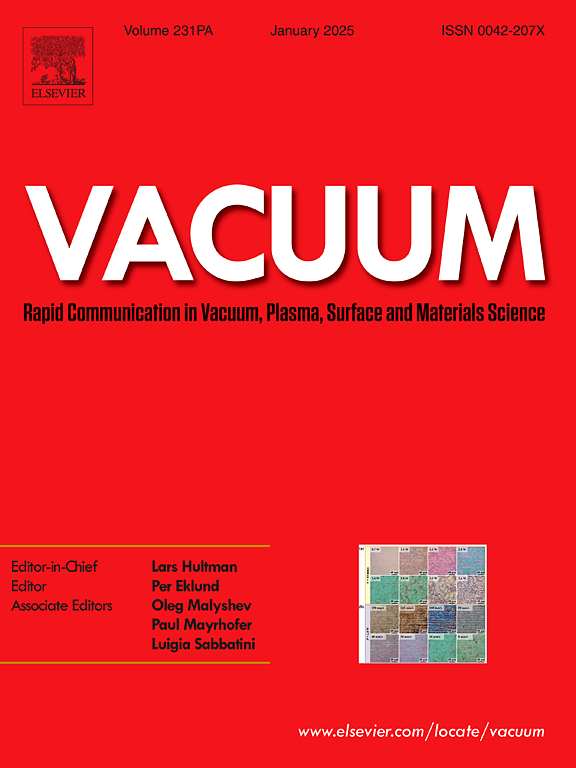在m面蓝宝石上引入AGO缓冲液,提高mocvd生长α-Ga2O3的质量
IF 3.9
2区 材料科学
Q2 MATERIALS SCIENCE, MULTIDISCIPLINARY
引用次数: 0
摘要
α-氧化镓在电力电子领域具有很高的Baliga FOM(bom),但其外延材料质量低劣限制了其应用的发展。本研究研究了α-Ga2O3薄膜中位错的形貌和行为,并通过插入(AlxGa1-x)2O3缓冲液显著改善了α-Ga2O3薄膜的表面形貌和晶体质量。结果表明,在失配应力松弛期间,缓冲层内的位错导致外延层相对于衬底整体倾斜(0.5°)。当薄膜达到一定厚度时,高密度螺位错向表面扩散,成为β-Ga2O3的成核位点,形成小丘,严重破坏了薄膜的表面质量。但缓冲层上的这些小丘作为屏障,促进α-Ga2O3薄膜的横向生长,使位错弯曲和湮灭。通过调整缓冲液的形貌,可以生长出高质量的α-Ga2O3薄膜,(30-30)摆动曲线的半最大值全宽度(FWHM)从0.46°降低到0.26°,表面粗糙度从15.1 nm降低到2.45 nm。这一工作证明了MOCVD在制备高质量α-Ga2O3薄膜方面的卓越能力。本文章由计算机程序翻译,如有差异,请以英文原文为准。
Improving the quality of MOCVD-Grown α-Ga2O3 by introducing an AGO buffer on m-plane sapphire
α-gallium oxide has great potential in the power electronics field due to its high Baliga FOM(BFOM), however, the inferior quality of the epitaxial material limits the development of corresponding applications. This study investigates the morphology and behavior of dislocations in α-Ga2O3 films and considerably improves both the surface morphology and crystal quality of the films by inserting an (AlxGa1-x)2O3 buffer. Results reveal that the dislocations within the buffer lead to an overall tilt (0.5°) of the epitaxial layer relative to the substrate during the relaxation of mismatch stress. Furthermore, high-density screw dislocations propagate to the surface when the film reaches a certain thickness, becoming nucleation sites of β-Ga2O3 and formation of hillocks which severely damaged the surface quality of the film. But these hillocks on the buffer layer act as barriers to promote lateral growth of the α-Ga2O3 film, making dislocations bend and annihilate. By adjusting the morphology of the buffer, high quality α-Ga2O3 film is grown with the full width at half maximum (FWHM) of the (30-30) rocking curve decreased from 0.46° to 0.26°, and the surface roughness is reduced from 15.1 nm to 2.45 nm. This work demonstrates the excellent capability of MOCVD in growing high-quality α-Ga2O3 films.
求助全文
通过发布文献求助,成功后即可免费获取论文全文。
去求助
来源期刊

Vacuum
工程技术-材料科学:综合
CiteScore
6.80
自引率
17.50%
发文量
0
审稿时长
34 days
期刊介绍:
Vacuum is an international rapid publications journal with a focus on short communication. All papers are peer-reviewed, with the review process for short communication geared towards very fast turnaround times. The journal also published full research papers, thematic issues and selected papers from leading conferences.
A report in Vacuum should represent a major advance in an area that involves a controlled environment at pressures of one atmosphere or below.
The scope of the journal includes:
1. Vacuum; original developments in vacuum pumping and instrumentation, vacuum measurement, vacuum gas dynamics, gas-surface interactions, surface treatment for UHV applications and low outgassing, vacuum melting, sintering, and vacuum metrology. Technology and solutions for large-scale facilities (e.g., particle accelerators and fusion devices). New instrumentation ( e.g., detectors and electron microscopes).
2. Plasma science; advances in PVD, CVD, plasma-assisted CVD, ion sources, deposition processes and analysis.
3. Surface science; surface engineering, surface chemistry, surface analysis, crystal growth, ion-surface interactions and etching, nanometer-scale processing, surface modification.
4. Materials science; novel functional or structural materials. Metals, ceramics, and polymers. Experiments, simulations, and modelling for understanding structure-property relationships. Thin films and coatings. Nanostructures and ion implantation.
 求助内容:
求助内容: 应助结果提醒方式:
应助结果提醒方式:


